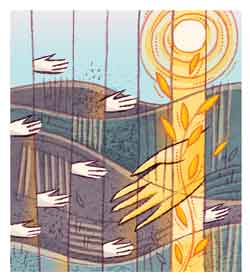Being Jewish
Commentary
A Seventh From Heaven

Rosh Hashana marked the beginning of 5775, a shemitta, or sabbatical, year in the Land of Israel. According to the Torah, “And six years you shall sow your land…, but the seventh year you shall let it rest and lie fallow” (Exodus 23:10). Working the land is forbidden; you can harvest only what you immediately need. An amnesty on debt is enacted, ownership is transcended—equal access to the land and its bounty is declared for all, humans and beasts alike.
Since the Jewish return to israel, the debate around shemitta has been whether the laws prohibiting agricultural work can be halakhically circumvented—religious Zionists say yes, haredim say no—but this discourse has obscured the enormous social justice and environmental implications of shemitta. Israel’s first chief rabbi, Abraham Isaac HaCohen Kook, understood shemitta in this broader light. He envisioned shemitta loosening the hold of free-market capitalism on the human spirit. In Rav Kook’s Introduction to Shabbat Ha’Aretz (Hazon), he writes:
A year of equality and of tranquillity, expansion of the soul and its widening towards the divine which sustains life with loving kindness…no violating of the holy that comes with insistence on private property…and the desire for riches, which is aroused through commerce, is quieted.
A deeper reading of shemitta is being resurrected. Minister of Knesset Ruth Calderon of the Yesh Atid Party and other Knesset members are promoting shemitta-inspired debt forgiveness for some of Israel’s poor. Also in Israel, an initiative by Teva Ivri is spearheading shemitta by distributing a Shmita Catalogue of activities and by outreach to inspire projects (swap markets, volunteer banks). In the United States, Hazon has published a Shmita Sourcebook, and its Shmita Project offers ideas (such as a community food gleaning trip).
The hope is that shemitta principles will eventually penetrate the global culture just as a weekly rest day is now accepted. Our task is to imagine and reflect on how shemitta could be observed today. This requires analyzing and intuiting the intent of shemitta in our texts and traditions while understanding our current reality and how it might be healed.
Shemitta and Yovel speak to perhaps the world’s greatest challenge, and that is the way the corporate-led search for economic growth, bereft of a larger vision of the common good, threatens to make permanent gross inequalities of power and income that threaten democracy, freedom and well-being. These forces, with their unchecked use of land, water and atmosphere, imperil the intricate tapestry of life that we all depend on.
In contrast, shemitta’s intent is to insure that private accumulation of wealth is contained and tempered by a larger vision that recognizes each individual’s needs. In my work in impoverished corners of the globe, I can say with assurance that extreme poverty strikes those who have tiny plots of land or none at all; landlessness leads to debilitating debt; and impoverished villagers become even more miserable slum dwellers. If a contemporary form of shemitta, the Jubilee and prohibition against interest were adapted, poverty would effectively be wiped out.
The stirrings in the Jewish world around shemitta indicate that perhaps now is the time when its message, like the Sabbath’s, can be heard by humanity. If we can articulate this message, the Jewish people may once again make an enormous contribution to the global culture so profoundly in need of a unifying ethics.
Rabbi Micha Odenheimer is founder of Tevel b’Tzedek. This article is adapted from a version published online in The Times of Israel.










 Facebook
Facebook Instagram
Instagram Twitter
Twitter
Leave a Reply